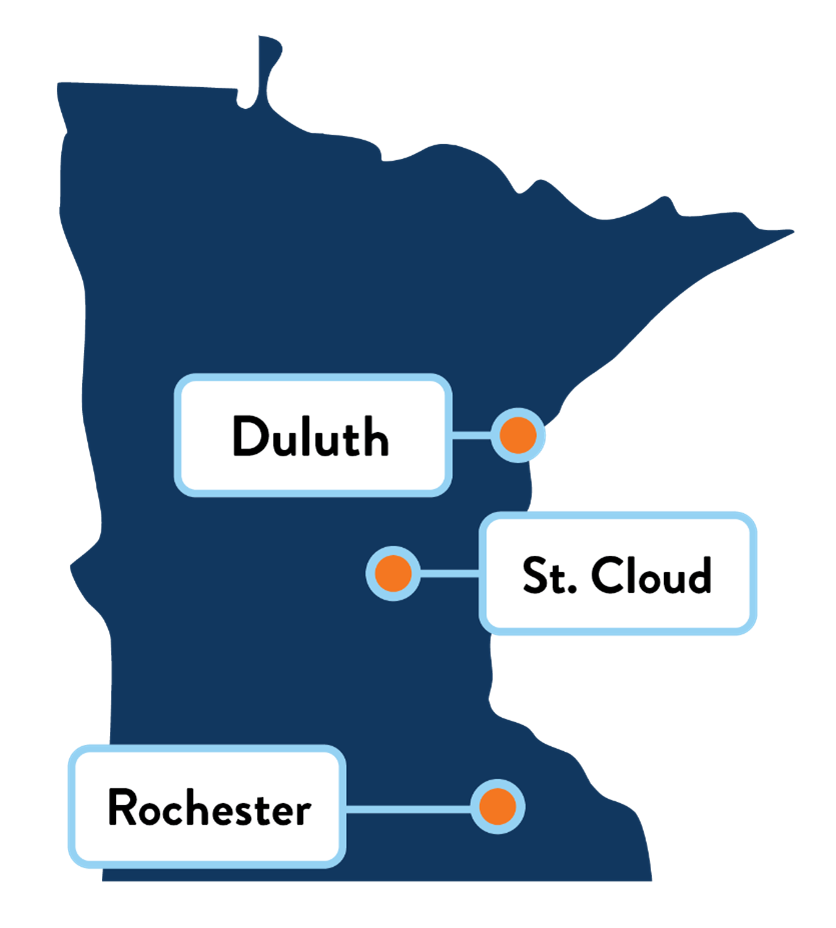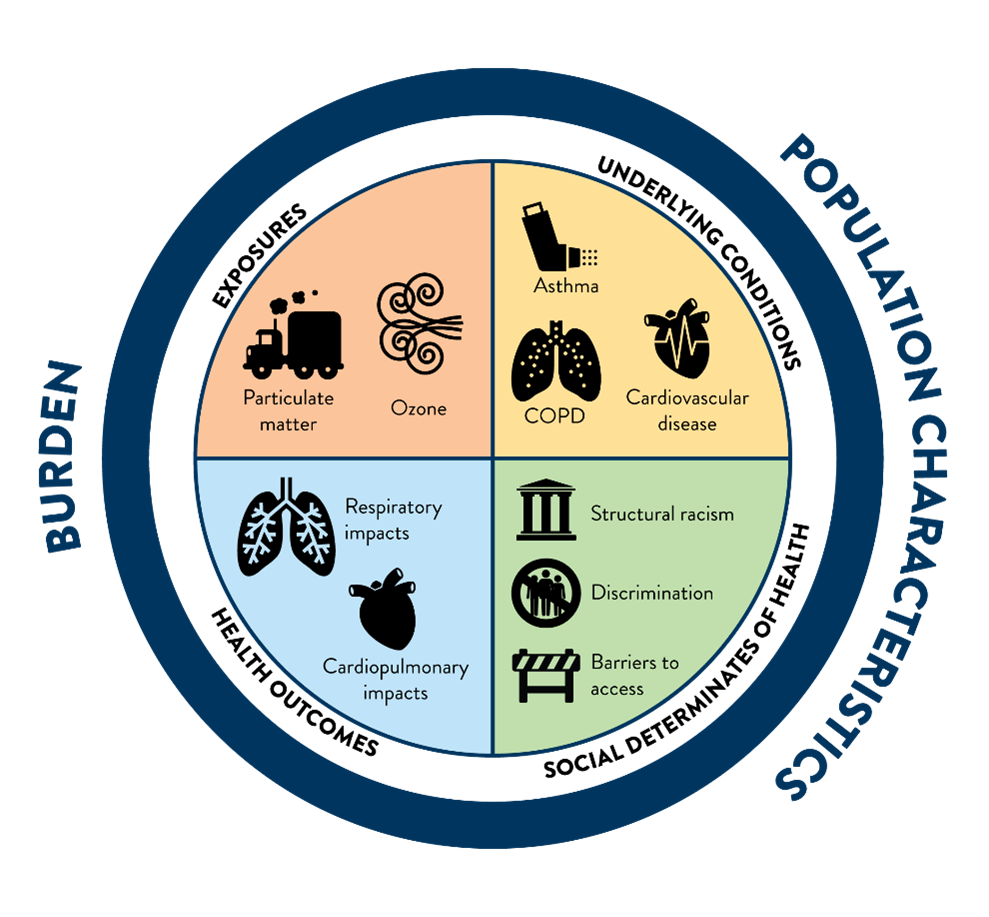Life and Breath Greater Minnesota 2022
Health impacts of air pollution
Life and Breath: Greater Minnesota (published 2022)
Life and Breath: Greater Minnesota (PDF)
Air pollution is a public health issue
Breathing polluted air creates or worsens numerous health conditions and can lead to early death. Although air quality in Minnesota meets current federal standards, environmental conditions are changing. For example, Minnesotans are experiencing a steady increase in seasonal smoke exposure from wildfires, triggering air quality alerts and heightening concerns about the health impacts of smoke and other air pollutants.
While all Minnesotans are susceptible to the health impacts of air pollution, these impacts are not equal. Differences in air pollution exposure, together with higher underlying rates of lung, heart, and other health conditions, can lead to disparate health outcomes for marginalized communities.
The Minnesota Department of Health (MDH) and the Minnesota Pollution Control Agency (MPCA) work together on the intersection of air and health. In this brief, we have estimated annual health impacts of air pollution (using methods from peer-reviewed literature ) in three of Greater Minnesota’s largest cities: Duluth, Rochester, and St. Cloud. The findings highlight population-level health impacts of air pollution as well as differences across demographic groups. From the analysis, we describe the impact on communities while adding to the body of evidence that some populations bear a heavier burden of air pollution and the associated health-related outcomes. Taking these findings forward to action requires conversations with communities most impacted by health inequities and environmental injustice to identify actionable interventions to improve and protect health.
Top takeaways

- Despite relatively good air quality in Duluth, Rochester, and St. Cloud, we find health impacts from fine particles and ozone pollution.
- Communities in Greater Minnesota cities with higher percentages of low-income residents, Black, Indigenous or People of Color (BIPOC) residents, uninsured residents, or residents living with a disability have the highest estimated air pollution-related death and disease rates.
- Chronic health conditions heighten susceptibility to the negative effects of air pollution in the body.
- We estimate that air pollution played a role in close to 9% – or about 200 – of all deaths in 2015 in these three Greater Minnesota cities. For comparison, in Minnesota the third leading cause of death in 2015 was accidents (6% of all deaths) after cancer and heart disease (22% and 18%, respectively).
Greater Minnesota air pollution contributes to early deaths
In an earlier Life and Breath report, MDH and MPCA evaluated air pollution and health data for 2013 and estimated air pollution contributed to more than 2,000 premature deaths in the state. For the current analyses with city data, Table 1 shows even low to moderate levels of fine particle (PM2.5) pollution in 2015 contributed to around 200 early deaths in Duluth, Rochester, and St. Cloud. Additionally, the table highlights the estimated percentage of all deaths related to air pollution, the rate of air pollution-related early deaths (per 100,000 residents), and the potential number of avoided impacts from better air quality.
Table 1: Estimated 2015 deaths attributable to PM2.5 pollution in Duluth, Rochester, and St. Cloud
| Geographic area | Deaths* | Percent of all deaths* | Attributable rate** | Deaths preventable with air quality improvements*** |
|---|---|---|---|---|
| Three cities combined | 203 | 8.5% | 92.0 | 21 |
| Duluth | 62 | 7.8% | 105.5 | 6 |
| Rochester | 74 | 9.5% | 88.3 | 8 |
| St. Cloud | 67 | 8.2% | 85.7 | 7 |
*All cause deaths for individuals aged 25 and older attributable to PM2.5
**Per 100,000 people
***Reduction of 10% of PM2.5 in air
Health inequities of air pollution

While air quality has generally improved over the past few decades in
Minnesota, gaps in the health impacts
of air pollution based on race and other marginalizing factors persist in the state. In these three cities,
disparities are not predominantly the result of differences in air pollution exposure, but more likely a
result from the already existing burden of lung and heart conditions. Populations in areas with higher
disease and death rates generally have more aging residents. Futhermore, structural inequities,
such as systemic racism, housing insecurity, discrimination in healthcare, and other social and economic
stressors, contribute to unequal health burdens of air pollution.
Figure 1 shows how the non-fatal but serious health impacts of air pollution vary across
Greater Minnesota cities’ zip codes depending on poverty, BIPOC, un-insurance, and disability levels. Areas
with more poverty, higher percentage of BIPOC residents, higher levels of un-insurance, or higher prevalance
of disability each show increasing attributable rates for every estimated health impact.
Figure 1: Demographic indicators of Greater Minnesota cities zip codes 2015: Non-fatal impacts from PM2.5 by poverty, BIPOC residents, un-insurance status, and any disability
Health inequities for heart and lung conditions are compounded by the stressors many communities experience, including emerging evidence connecting the number and severity of COVID infections (including deaths) and poor air quality.[i] [ii] Although the data analyzed in this brief predate the COVID-19 pandemic and recent spike in wildfire events, there is evidence that long-standing areas of local air quality inequities have continued throughout Minnesota.
Progress and the path forward
The goal of this analysis was to describe the impact on communities and add to the body of evidence on the experience of at-risk populations. MDH and MPCA have taken steps to address underlying inequities in air and health as the data show marginalized communities bear a heavier burden of air pollution and the associated health-related outcomes.
MDH makes connections between the environment and health using air quality and demographic data. Reducing air pollution is part of the overall strategy to address structural inequities in healthcare, housing, and other social factors that influence health.
One of MPCA’s key strategic goals is to improve air quality in Minnesota population centers, including Greater MN cities. The Air We Breathe 2021 legislative report, the latest edition of a biannual report that describes the state’s air quality to inform and guide policies, highlights sources of air pollution and outlines the unequal exposures to pollution.
Below are additional resources for communities along with links to more specific data tables to complement this high-level summary.
What is being done about air pollution and its health impacts?
These study results, other MPCA and MDH analyses and meaningful stakeholder engagement will help us direct pollution reduction resources. This can help address environmental justice and health equity goals, including inequities like air pollution and access to health care. Recent progress includes MPCA grants through the Volkswagen Settlement and MDH programs like the Eliminating Health Disparities Initiative.”
MDH and MPCA work together on the intersection of air and health. This study is the result of a collaboration between MDH and MPCA. See the Life and Breath: Metro (updated 2022) (PDF) here or learn more from MPCA.
Health and environmental justice data tools
- CDC’s Environmental Justice Dashboard
- CDC's Environmental Public Health Tracking
- CDC's Heat and Health Tracker
- CDC's Social Vulnerability Index
- MPCA’s Understanding Environmental Justice in Minnesota interactive map
Related links
- See current air quality conditions and sign up for air quality alerts.
- Air quality and health
- Asthma
- Heart Disease
Publication date: January 2022.